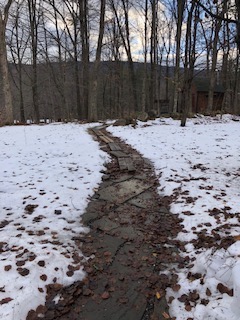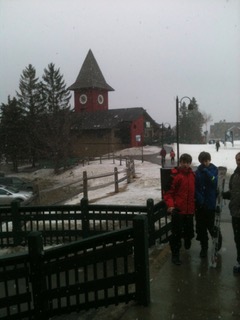
While walking in my shirtsleeves in the balmy 58-degree sunshine on Sunday, I started to wonder if the ski industry is really good for Vermont.
I’ve lost my enthusiasm for downhill skiing over the years, developing not just a dislike for the ungainly equipment and prohibitively expensive lift tickets, but also for the industry’s ginormous carbon footprint.
Green is good, but . . .
For a state that prides itself on being green, we also do much to promote this activity that guzzles fossil fuel and produces a huge amount of waste. While resorts may tout their natural gas shuttles, they overlook the thousands of SUVs their patrons drive to get to the slopes. While the resorts may brag about changing from Styrofoam to corn-based clamshells in their fast food joints, that begs the cost of producing that packaging in the first place, and both the compliance and the energy required to recycle it all once it’s been used.
Recycling is not energy-free.
Downhill skiing as it is practiced now isn’t good for the environment, nor is it good for the local economy, as may have once been.
Who profits?
In the beginning of skiing in Vermont, ski areas were locally owned, and skiers from away rented lodging or bought second homes and shopped and dined locally. Now, Vermont’s ski areas change hands so often, it’s hard to keep track of which resort giant is now in control.
But they are in control: they own the mountain-side housing, dining, equipment rentals, and even après-ski entertainment, so that resort guests never have to leave the mountain – or spend a dime at a local establishment, except to buy gas on their way home.
What about affordable housing?
Meanwhile, the high-end condos are empty many months of the year, while the Vermonters working low-wage service jobs at the mountain cope with Vermont’s lack of affordable housing.
Climate Change
And it can’t last. While it’s possible now to turn off Route 100 into a manufactured winter wonderland, making snow won’t be possible if the temperature continues to rise and/or if water dries up. Sunday’s high of fifty-eight degrees has only dropped to forty-one today: hardly typical Vermont winter temperature.

Protecting the Environment
What we should be doing is protecting the environment by promoting non-motorized, low-impact outdoor activity and developing a transportation infrastructure so people don’t have to rely on private cars to get any- and every- where.
It’s certainly better that people ski than not get outdoors at all. And yes, it’s wonderful that Vermont has produced some gold medal Olympians both on snowboards and skis, in part a result of making it possible for school children to participate in a sport they may never be able to afford. But I think it would be better to put these kids on snowshoes so they can learn their way in the woods in a more sustainable way.
And I think getting people outdoors without all the urban trapping of music, lift-lines, and the rudeness that seems to congregate with human crowds would benefit everyone and the environment alike.
Your passionate and contrary comments are most welcome as long as they are also polite.

Hey there Deborah.
Interesting article.
I agree and disagree.
It’s sad the big once family owned places, are many times corporate owned now.
That’s a negative. And the viability of snow blowing as temperatures potentially warm, is green negative.
But while the resorts do have a great deal of on site activities, it is also true that many skiers do frequent the outer areas when visiting.
We have numerous groups of out of staters venturing north by rail and car for the next few weekends; not only to visit mom and pop, but to ski and shop.
I just dropped a good amount of cash at Hannafords to feed and beer the crowds. As well, we will be hitting up a local restaurant after the Amtrak drops them off, Friday p.m.
Youngest has some worn out boarding boots, so he’ll want to look around to buy new once here. And Alan’s daughter in law loves the cheese shop in Brat, money will be dropped there as well.
I am not a mountain skier. Used to do some cross country and snowshoeing. As we have some trail acreage right here, hoping to get reoutfitted for those more passive outdoor activities. But I am glad our friends and family like to come and visit, get outdoors and ski, whatever the type, rather than staying indoors all winter.
I am not totally in the know, or up to speed on second home taxe percentages, etc. From what I understand, the second home owners pump a lot of tax $ into the system. At a time when the alarmists are warning about a potential mass exodus from this beautiful state, I am glad to see folks enthusiastically crossing over the border for sport recreation.
🙂 robin g
Deb, I love all your writing. This one is spot on!